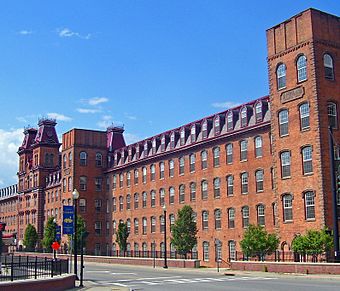Harmony Mills facts for kids
|
Harmony Mills Historic District
|
|

Partial front elevation of mill building in 2008
|
|
| Location | Cohoes, NY |
|---|---|
| Architectural style | Second Empire |
| NRHP reference No. | 78003151 |
Quick facts for kids Significant dates |
|
| Added to NRHP | January 12, 1978 |
| Designated NHLD | January 20, 1999 |
Harmony Mills is a historic area in Cohoes, New York, United States. It's located near the Mohawk River. This area was once home to huge factories that made cloth.
In 1978, it was recognized as the Harmony Mills Historic District on the National Register of Historic Places. Later, in 1999, some of its main factory buildings and worker homes were named a National Historic Landmark. One of the most important buildings, Harmony Mill No. 3, was listed on the National Register in 1971.
When it opened in 1872, Harmony Mills was the largest cotton mill complex in the world! It's a great example of a huge textile mill (a factory that makes fabric) outside of New England.
After a company called Barclay Home Products closed in 1988, the complex started to decline. Mill 2 burned down in 1995. Mill 1 was also badly damaged by a fire in 1998.
A developer named Uri Kaufman bought the complex in 2000. He had a vision to bring it back to life.
In 2005–2006, part of Mill 3 was updated and turned into fancy apartments called "lofts." These 96 apartments were quickly rented out. A second group of 135 apartments was finished in 2010. This phase included a pool and spa. These apartments were called Harmony Mills Fallsview Luxury Apartments because they had great views of the Cohoes Falls.
In early 2013, work began to restore Mills 1 and 4. Mill 4 was finished in December 2013, and almost all of its 33 apartments were rented even before it was officially open. In total, Harmony Mills now has 340 luxury loft apartments.
The success of Harmony Mills helped the City of Cohoes grow. In 2010, the city's population increased for the first time since 1930. Cohoes was even named the fastest-growing city in New York State in 2015 and 2016. This project is a great example of how old, unused buildings can be given new life. This helps cities grow and cleans up old, empty areas in a good way for the environment.
Uri Kaufman received an award for his work on Harmony Mills. The project is even featured on the New York State Historic Preservation Office Website as a top example of historic building development.
Contents
Mill No. 1
The location of Harmony Mills was very important for its success. The powerful Mohawk River Falls provided energy, and the Erie Canal helped transport goods. Mill No. 1 was the first textile mill built here, completed in 1837. It housed the operations of the new Harmony Manufacturing Company.
This mill had a special roof style, like those seen in Greek revival architecture. Its construction led to the Erie Canal being moved. The east side of the mill then became a canal for the company to use for water power. The mill was also very close to Lock No. 16 of the Erie Canal.
The first owners didn't make a profit. So, in 1850, Thomas Garner and Alfred Wild bought the building. Robert Johnston, a very experienced cotton mill worker, was key to this purchase. He was hired as the company's new supervisor. Johnston quickly showed his skills. Under his leadership, the company needed to add more space to Mill No. 1. This addition was a beautiful five-story building, 274 feet long, with a large tower and an arched entrance.
Picker House / Storehouse / Pump House
In 1853, the company needed a "Picker House" to make production more efficient. This building was used to open and clean the large bales of cotton that came in. It also served as a storage space. Today, this building and part of the walkway to Mill No. 1 still stand.
Mill No. 2
Mill No. 2 was built in 1857. It showed how much cotton production was growing in Cohoes. This mill was an extension of Mill No. 1. In 1866, a fourth floor with a special mansard roof was added. Sadly, Mill No. 2 was badly damaged by a fire in 1995 and was later taken down.
Mill No. 3
Because of continued success, construction began on the most important of the mills in 1866. The first part was finished in 1868, and the second in 1872. Mill No. 3 was huge, measuring 1,185 feet long and 70-76 feet wide. It stood five stories tall and had beautiful Victorian-style features. These included its mansard roof and a bronze statue of Thomas Garner near the front towers. Mill No. 3 was a symbol of the great success of the Harmony Factories. In the basement, two powerful 800-horsepower turbines powered all the machinery in the mill.
Mill No. 4
In 1872, the Harmony Company bought what was once the Van Benthuysen Mill. They turned it into another cotton mill. This mill was mainly responsible for making cotton bags and jute products.
Other Buildings
Besides the main mills, there were other important buildings. These included the Boiler House (built around 1911), the Office and Sunday School Building (around 1853), and the Generator Plant. Today, the Office and Sunday School Building is used for businesses, including a salon.
Tenements
The rapid growth of Harmony Mills brought many immigrants to Cohoes. The Johnston family, who ran the mills, built over 800 "tenements." These were simple homes provided to immigrants and their families at very low costs. The only condition was that they had to work in the mills. This allowed the mills to hire over five thousand workers. It also helped Cohoes become the largest producer of wool knit goods in the United States in the 1860s.
Images for kids





